Some of you may recall that last November I photographed an amazing encounter between a Prairie Falcon and a hapless Northern Shoveler along the causeway to Antelope Island. These are photos of that experience that I haven’t posted before.
1/2000, f/5.6, ISO 500, 500 f/4, 11.4 tc
I watched the relatively young female falcon strike the duck on the surface of the water where it quickly died – this photo was taken just seconds after the strike. But retrieving the Shoveler from the water and flying it to shore would have been difficult so the falcon used an alternate strategy. It flew over the floating duck multiple times (apparently just checking it out) and then simply waited on the shore of the causeway until the breeze and the waves washed the Shoveler ashore.
Note: I’ve included eight photos here and the last one is a little gory so some may prefer to avoid scrolling to the final image.
1/2500, f/6.3, ISO 640, 500 f/4, 1.4 tc, not baited, set up or called in
Here the falcon is only a few feet from the Shoveler (just out of frame to the right) as it cautiously approaches the duck that has finally washed to shore. The bird was nervous (the causeway road was wet so the traffic was making a lot of noise) but it wasn’t about to give up on its hard-won prize.
1/2000, f/6.3, ISO 640, 500 f/4, 1.4 tc, not baited, set up or called in
As soon as the falcon reached the duck it held its wings up, seeming to celebrate its success.
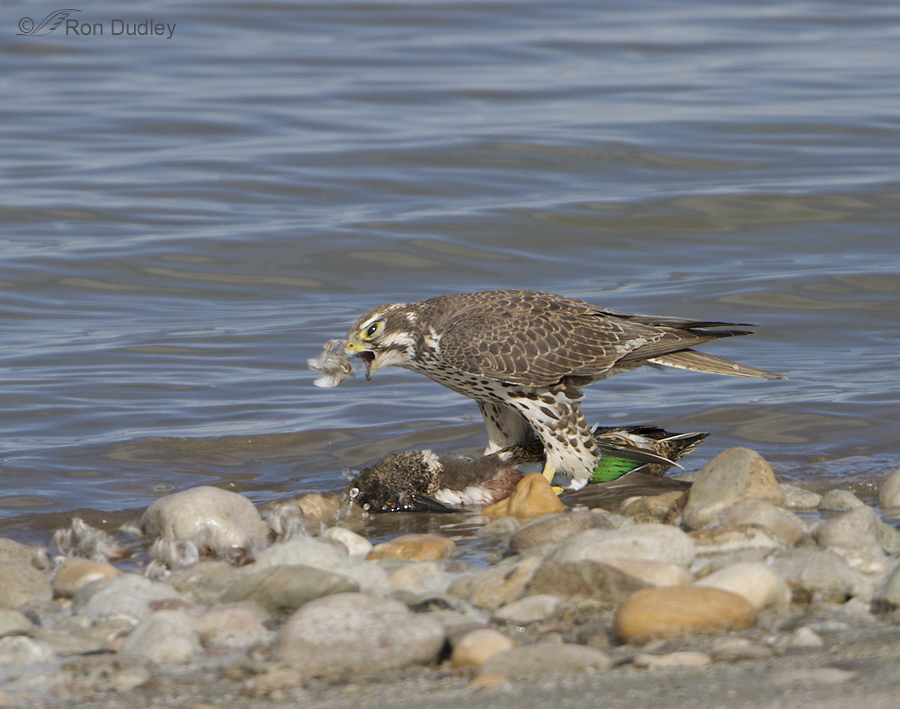 1/2500, f/6.3, ISO 640, 500 f/4, 1.4 tc, not baited, set up or called in
1/2500, f/6.3, ISO 640, 500 f/4, 1.4 tc, not baited, set up or called in
The falcon attempted to enjoy its meal on the spot where it washed to shore but incoming waves continually “rocked the boat” which obviously made the bird uncomfortable so…
1/2500, f/6.3, ISO 640, 500 f/4, 1.4 tc, not baited, set up or called in
it decided to drag the duck further up the rocky, bumpy shore which turned out to be rather a formidable task.
1/2500, f/6.3, ISO 640, 500 f/4, 1.4 tc, not baited, set up or called in
Watching it struggle to do so made it clear to me that the falcon would have had a very difficult time retrieving the duck from the water’s surface and its decision to wait for the prey to wash ashore was a good one.
1/2500, f/6.3, ISO 640, 500 f/4, 1.4 tc, not baited, set up or called in
Here the falcon has decided that this is far enough. It held its wings up for a few more seconds…
1/2000, f/5.6 ISO 800, 500 f/4, 1.4 tc, not baited, set up or called in
And then proceeded to enjoy its meal.
I have many more interesting photos of the falcon eating the duck but by now thick clouds were moving in and as you can see from my techs I was beginning to lose good light so I’ll spare you any more gore.
I was amazed by the apparent strategy of the falcon to wait until the duck washed ashore. This bird had been hanging around this area for several months and I suspect that it had used the same strategy multiple times before.
The adaptability and resilience of nature sometimes astounds me.
Ron


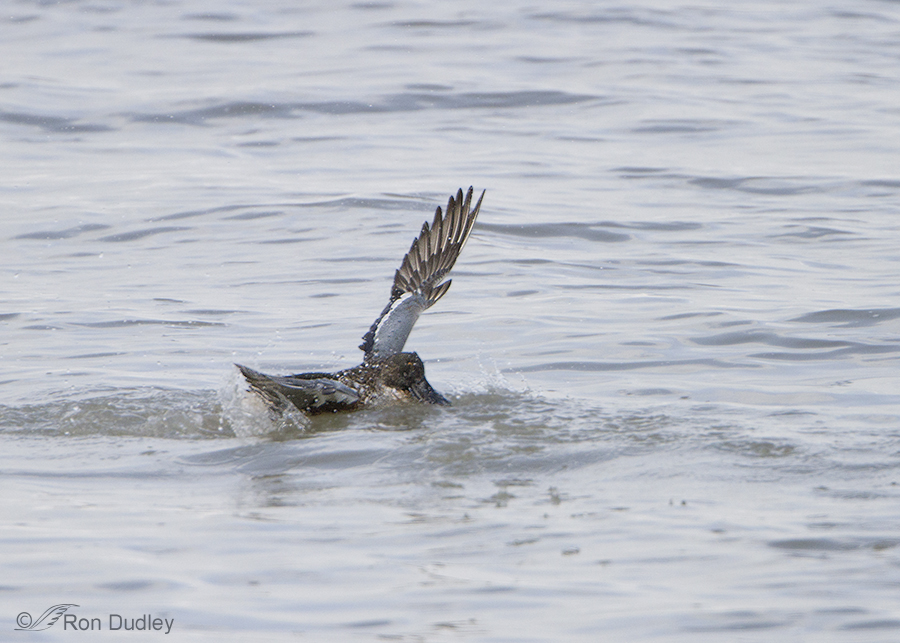
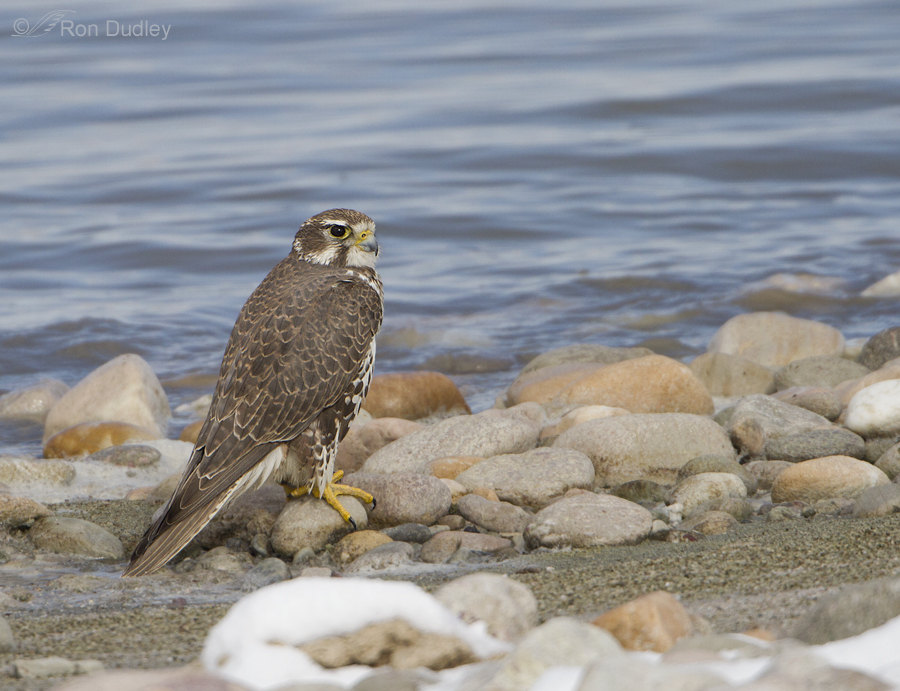
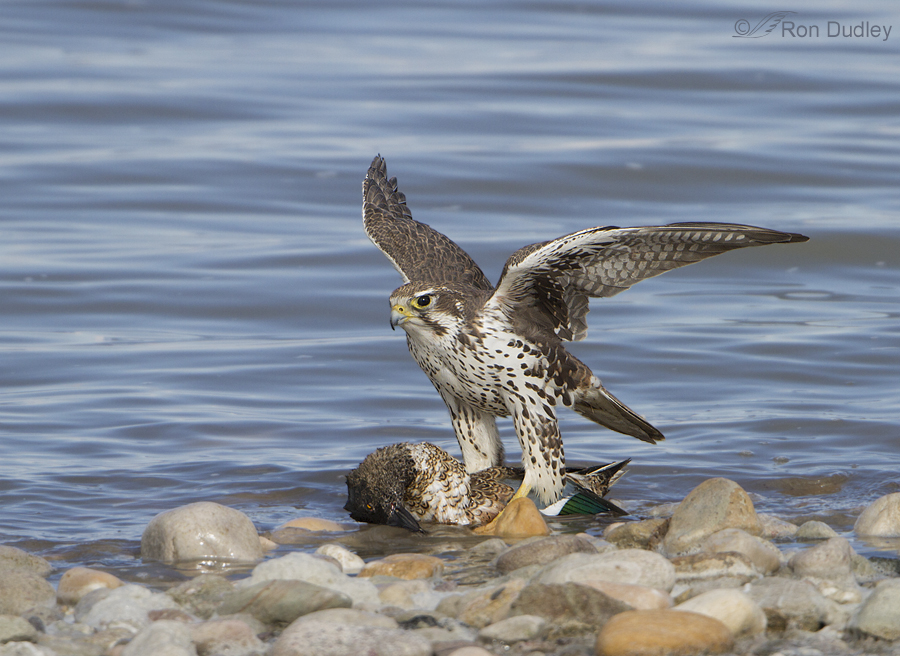
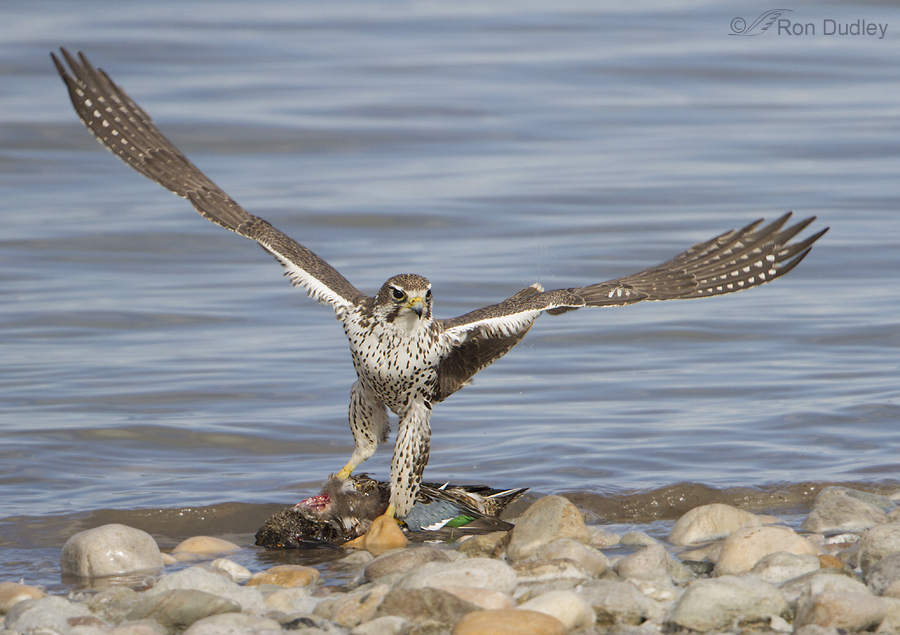
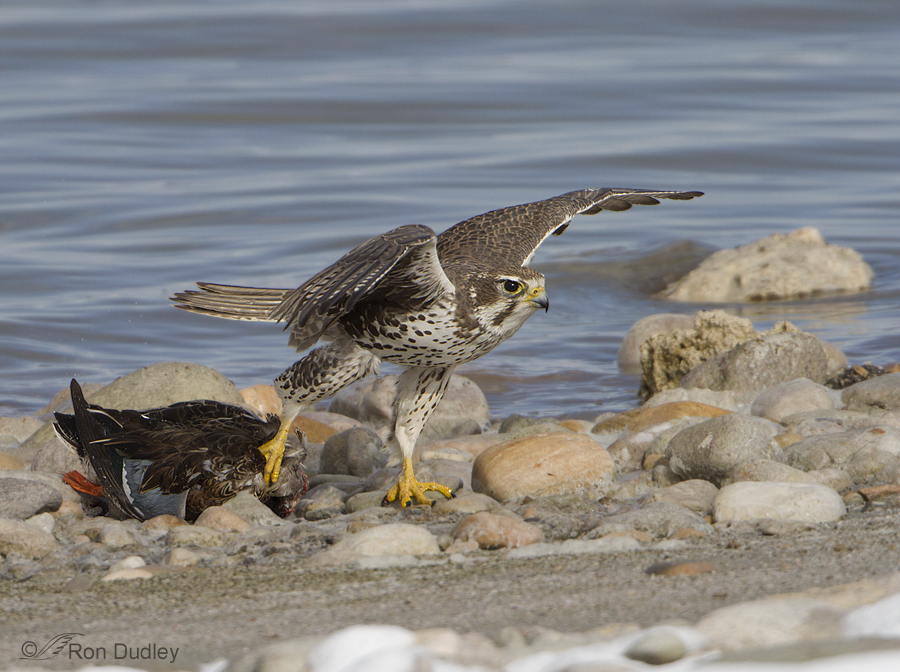
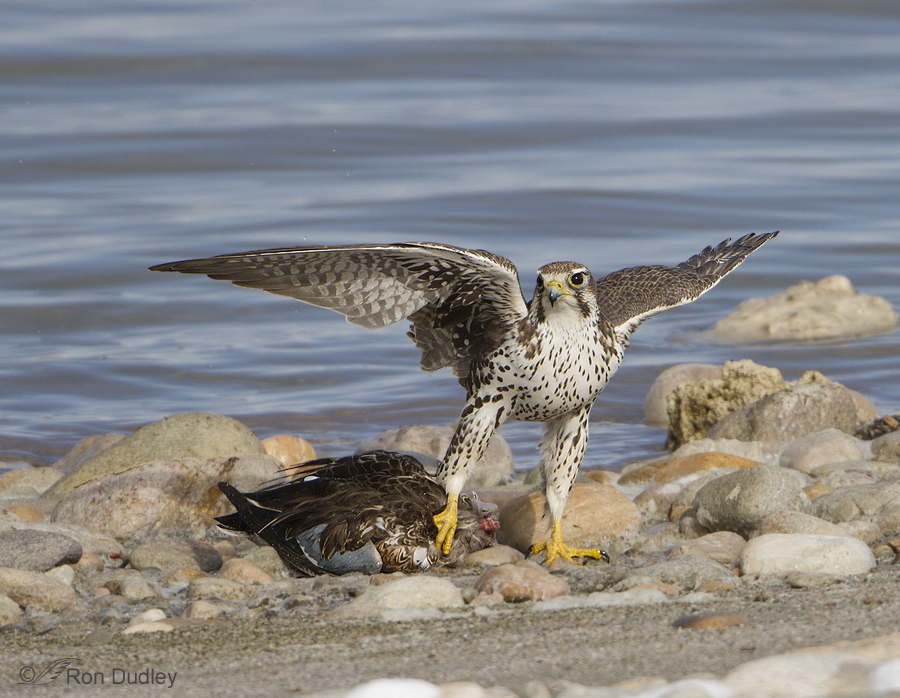
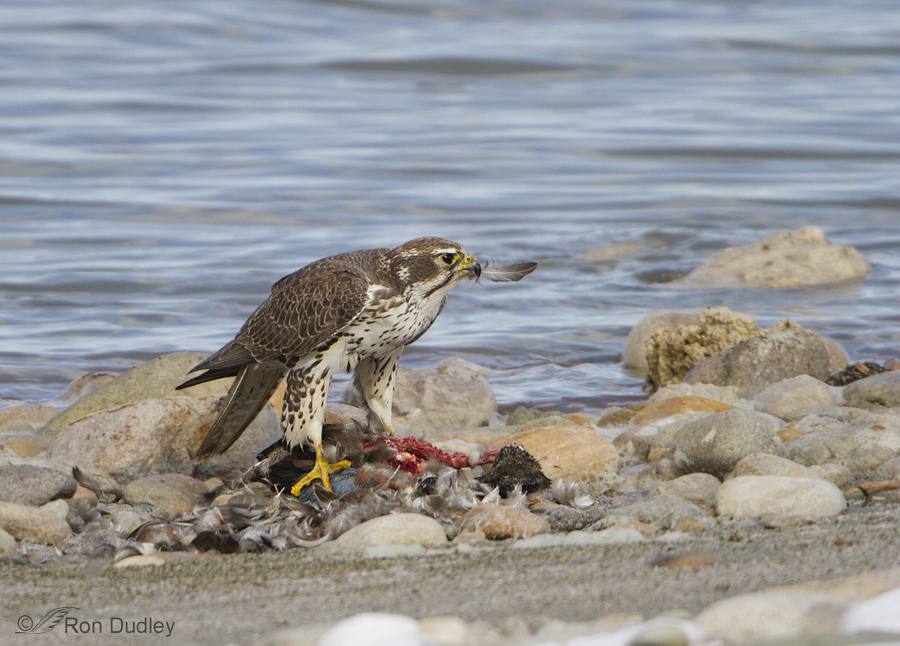
Fascinating, Ron! Like you, I think that many animals are smarter than we realize. I saw a documentary a few years back and I can’t remember which university it was at, but a PhD student had done her research work on crows, learning some amazing things in the process. Apparently crows have facial recogniton (the ability to recognize a specific human face) and they can transfer or share their memories with other crows not only now but for multiple generations. For example, let’s say I’m not so nice and I throw rocks at a crow in the park. Not only will that crow specifically recognize my face (and presumably other physical characteristics) and sound an alarm every time he sees me, but even if the specific crow in question were not around, other crows would now recognize me and sound an alarm whenever they saw me, even though I’d never done anything to them. This memory is transferred apparantly to the next two generations and even though the one crow that I had thrown rocks at is now long dead, his or her grandchildren will still sound the alarm whenever I appear, even though they were not even alive at the time of the incident and new nothing of it. This same memory transfer held true for positive events, as well, apparently. If i had fed the crow, instead of stoning him, that happy memory would have been shared with his colleagues and children and grandchildren and whenever I appeared in the vicinity of any of these crows, they would recognize me and roll out the red carpet for me, so to speak. It was an interesting insight into how “bird brains” are alot more than we think.
How nice to see a tribute to ‘bird brains’. What a brilliant strategy that Prairie Falcon developed. I wonder whether it had seen others do it, or had ‘thunk it out for itself’, perhaps after luck had brought an earlier kill to shore.
You and I speculate about the same things, Elephant’s Child.
A really interesting story and nice to see a bit more of it. I was told a few months ago that “birds are smarter than we give them credit for” and this tends to add evidence to that, especially in a young bird.
Intelligence is often hard to measure in some vertebrates, Sonja but seeing something like this sure made me wonder…
Raptors don’t swim “well”. And plucking a wet (or even dry) prey from the water often will exceed the load lifting abilities of the raptor. There is added risk because of the “locking” workings of the toes/talons mechanism. So many raptors fear deep water. (They will bath in shallow water but recognize the danger of deeper depth water bodies. Some of this must be learned because numerous juveniles will mistakenly fail to release prey they have grasped. The weight of these prey items dropping the predator and prey into water. And in the case of some Sea eagles and Osprey pulling them into the water. “Swimming” is accomplished by rowing action of the wings (much like the human butterfly style) but can result in drowning. (For more understanding of feathers and waterproofing you might care to read: Feathers: the evolution of a natural miracle. Hanson, Basic Books, ISBN 978-0-456-02013-3)
Raptors employ many strategies for successful hunting. Teamwork between a pair (Balds) or pack like teamwork (Harris’s Hawks), downing by smaller accipiters (as mentioned), running down prey (Cooper’s Hawks), driving prey into solid objects (Merlins), distraction by Redtails dealing with snakes…. and many more.
Raptors often take prey larger than themselves. From Geese by Gyrs (as mentioned) to Robins by Pygmy Owls. Hares and Rabbits by various hawk species and more…
Bill
William – I am interested that you mention the locking toes/talons mechanism as a negative in the case of carrying something too heavy. I have always assumed that the opposite would be true. i.e., if the prey item was extra heavy, the legs would be pulled down, thus straightening the hock joint and RELEASING the locking mechanism of the toes. Obviously they can voluntarily keep their toes flexed, but the ratcheting action is released. It’s when the hock is flexed that the toes can lock – true of any bird, as I understand it, and what enables a bird to sleep on a perch standing up. We use this info in a very direct way, in case we get ‘footed’ by a raptor we are handling – we know we won’t be able to get the talons out of the human body part that has gotten nailed unless we extend the hock joint all the way straight (and even then, with a bald eagle and my forearm, it took pliers!) … with the hock joint flexed, you can break the toes if you try to unclench them. For this reason, I have always assured folks that it’s an old wives tale that osprey can drown if they hook a fish that’s too large to fly with … but maybe I’m wrong?
I believe what occurs in the case of drowning Osprey (in particular) is the Osprey often plunges under the water surface to grasp the fish and is held under too long and partially refuses to let go of the fish in combination with the struggling fishes behaviour. Combine that with the locking mechanism. Osprey certainly have drown before and many other raptors have been dragged to the point of injury because of the locking mechanism combined with a lack of willingness to “release” their prey. I believe you have two opposing behaviours or actions occurring. Like many things a double edged sword. Raptors rarely willingly let go of any struggling prey within their grasp. It is generally counter-productive in the big picture.
BTW I have released countless talons by force without ever a broken toe.
Bill
Interesting information, as always, Bill. I’m sure my readers appreciate it as much as I do. I wondered the same thing that Louise did about the locking mechanism.
This is a fascinating story. I love seeing how wild creatures can get so creative – clearly they are very intelligent. These are beautiful photos of a beautiful bird. I’m really glad you shared more of this story.
Thanks, Susan. I’m glad you enjoyed seeing more images of this encounter.
A wonderful sequence Ron. Thanks for sharing.
Thank you, Bryce. I was wishing you were still around here when I visited HWI this afternoon.
Ron, your sequence reminds me that nature can teach me that patiently waiting is often better than exerting energy and perhaps in the end either losing the “prize” or getting hurt. Thanks
There are lots of lessons we can learn from nature, Diana.
I’m so glad you posted more on this experience. I loved your original post and appreciate the opportunity to see more of your magnificent photos of this event. Thank you.
Thanks, Sharon. I had more images of the encounter and wanted to share them.
What a privilege to be able to see this stark, remarkable process. Thanks so much for capturing it so vividly and sharing it with us, Ron.
You’re very welcome, Alison.
Very cool indeed! Maybe he was really hungry once & used this method & now has found it’s a relatively easy way to obtain dinner. I watched a video on the web not long ago of a Gyrfalcon killing a Canada goose in flight. Quite spectacular!
I think you may be right about how this bird developed the skill, Deb.
Beautifully shot series of images and very interesting behavior/description of behavior. I recall once seeing a sharp-shinned hawk drown a red-bellied woodpecker in a nearby creek when the woodpecker wouldn’t stop kicking after being brought down. The sharpie flew the bird to the creek then stood on top of it as it drowned in the shallow water. This didn’t happen easily, it took at least two tries before the bird, a young male, died. Thanks for sharing your wonderful photography!
That sharpie/woodpecker encounter must have been an incredible one to watch, Kelly. Amazing.
Wonderful shots! Amazing the instincts for survival lead to fascinating behavior. I had no idea that these amazing birds would be close to traffic. Thanks for the shots and info. Ron!!
Charlotte Norton
Charlotte, I think the tolerance this falcon had for traffic was unique to this particular bird. It had hunted the causeway for weeks and probably just became acclimated to it.
Excellent job, excellent behavior images, many thanks for sharing.
It is interesting to me that a falcon would go after such large prey; must have been very hungry to risk problems that might have occurred.
Dick, I’m wondering if it had perfected a skill specific to this location and situation. It had no problem at all killing the duck, didn’t have to lift it off the water and it certainly provided a nice meal.